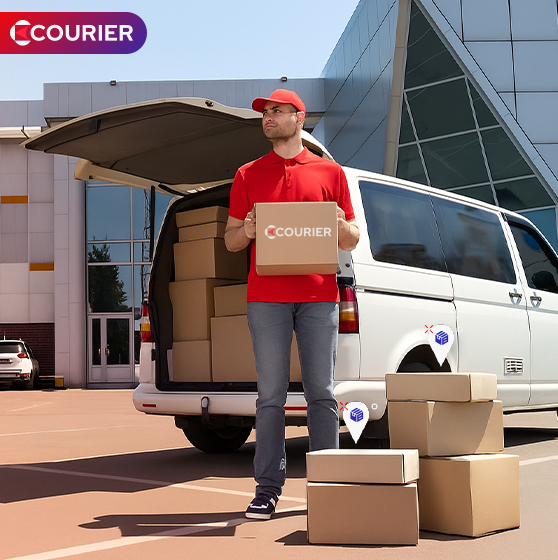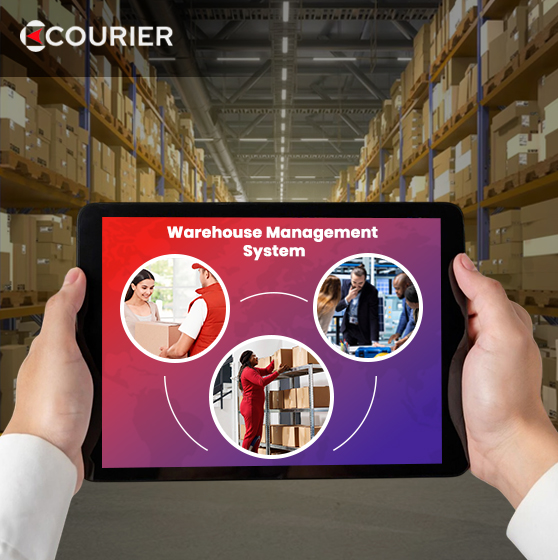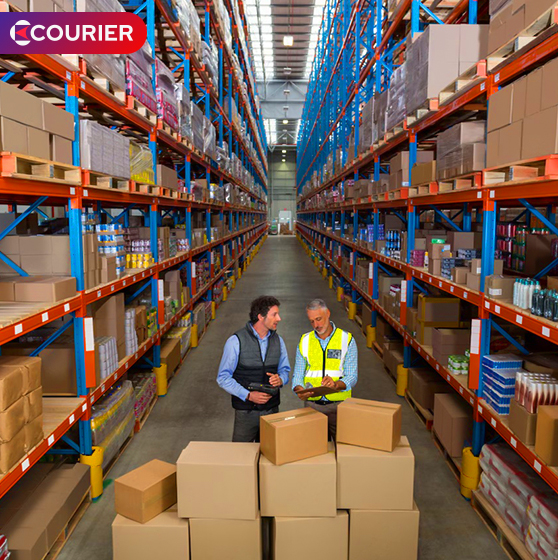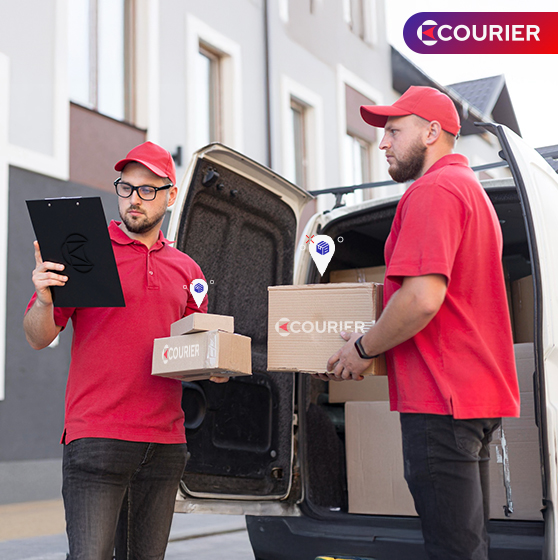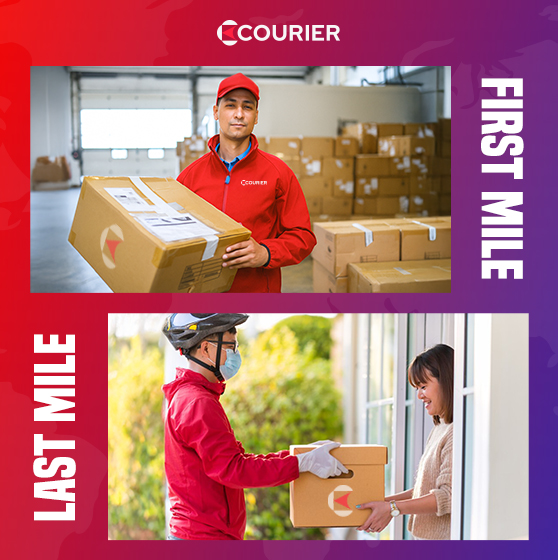
In logistics and supply chain management systems, the terms “first mile” and “last mile” delivery are practical concepts. These concepts are crucial to delivering a product from the manufacturer to the consumer.
In the current scenario, e-commerce is experiencing significant growth, driven by intense competition from high-end players in the market. Every business focuses on securing a vast clientele and ensuring seamless logistics operations.
Most people depend on online shopping platforms, seeking quick delivery options. Considering the booming online marketing, it is crucial to understand these phases. They streamline operations and improve customer satisfaction.
The first mile delivery is the initial movement of goods from the supplier to a central distribution center.
On the other hand, last mile deals with the final stage of delivery. Here, the products are directly transported from the distribution hub to the customer.
In this blog, we will explore the concepts of first mile and last mile delivery, their importance, and functionality. We will further discuss the challenges faced and steps to optimize the whole process.
Start reading!
First mile and last mile delivery in the supply chain refers to the beginning and end of the delivery process. These terms deal with the different stages of product movement during the supply chain process.
The professionals handling the entire delivery process ensure a seamless and cost-effective journey.
Table of Contents
What Is First Mile Delivery Logistics?
First mile delivery refers to a term created by the logistics industry, signifying the initial stage of the supply chain process. It establishes the groundwork for the whole delivery procedure.
It includes selecting large bulk orders from the sellers, manufacturers, and producers’ storage facilities. And it is followed by delivering them to the desired location.
They can serve as a fulfillment or distribution center, as well as a warehouse. Generally, it is carried out in huge amounts, with a set timetable and path, along with stops.
The retailers consider it to be the transfer of products from a local distribution center to various stores.
However, the term “first mile” directly implies the movement of goods from a factory or manufacturing facility to a distribution center for producers.
How Does It Work?
While considering first mile delivery, a courier service collects orders from the manufacturer’s location. This is the beginning of the shipping process. Once the orders are dispatched from the warehouse, they are processed and transported to the next distribution center.
The courier company must have the necessary information about the warehouse pickup location, weight, size, dimensions, and other vital product information.
Once packaged, these items are placed onto delivery trucks or alternative modes of transport. A suitable path is set up to move them to a storage facility or distribution hub.
When these items reach the distribution center, they are recorded, checked, and properly stored.
On completing these stages, the first mile delivery process is done, and the items are prepared for pickup. Finally, they are sent to the last mile for delivering the products to the customers.
What Is Middle Mile Delivery?
Middle mile delivery is also known as second-mile delivery. It involves the transport of products from a warehouse or distribution hub to fulfillment centers. It connects the initial mile and the final mile. It deals with large quantities of goods over extended distances.
What Is Last Mile Delivery Logistics?
Last mile logistics is the final phase in the product delivery stage. Here, the products are collected from the distribution center and delivered to the customer. Consumers and businesses place more emphasis on last mile delivery.
Wondering what last mile delivery means? It provides quicker and more affordable options, including instant or same-day delivery. It is more beneficial and focused for the business owners.
The last mile delivery consists of picking individual SKUs (stockkeeping units). It is used in tagging them for shipment to their ultimate location. If the product is returned to the retailer, the alternative method is known as reverse logistics.
How Does It Work?
Last mile delivery starts when the purchased items arrive at the closest distribution center. Then the carrier picks up and loads the parcel from the center and delivers it to the drop-off location.
Generally, the destination is specified on the parcel and is also updated in the software. The process ends when the delivery staff delivers the package to the customer.
The products in the logistics process pass through different facilities. Once the package reaches the last distribution center, it marks the beginning of the last mile segment of the delivery process.
The carriers assign the packages to the drivers using advanced technology. It helps them determine the hassle-free delivery routes.
The customers use tracking numbers to follow their packages throughout the delivery process.
They are scanned before being loaded onto the delivery trucks or vans for the last mile delivery. It helps the customers understand that their package is out for delivery.
Finally, shipments arrive at the recipients’ homes, and the carrier provides proof of delivery. Technological advancements and increased focus on sustainability drive the future of last mile delivery.
Difference between First Mile and Last Mile Delivery
First mile, middle mile, and last mile delivery are essential elements of the supply chain. Each of the stages serves unique functions and has significance.
Effective handling of every phase is crucial for the overall success of the supply chain, customer satisfaction, and productivity.
First mile delivery involves the initial logistics of transporting goods from the seller’s location. Whereas, last mile delivery pertains to the final operations in the supply chain.
First mile entails collecting orders from the producer or vendor via a courier and delivering them to the carrier. Last mile delivery concludes when the order arrives at the customer’s door.
First mile and last mile logistics differ in their functionality, cost structures, and impact on customer experience.
Here are the differences between First Mile vs Last Mile Logistics –
Process Flow:
First mile delivery involves transporting large quantities of goods from the producer to a warehouse or distribution hub. Generally, it utilizes larger vehicles with fewer stops. Last mile delivery transports individual packages directly from the warehouse to the customer’s home. It frequently utilizes smaller vehicles and makes more stops.
Cost:
Another factor to consider in first mile/last mile transportation is the cost.
First mile delivery is usually more affordable because of the higher volumes and reduced number of stops. On the other hand, last mile delivery is usually more expensive. The main reasons are the challenges of navigating city areas, processing smaller shipments, and coordinating various delivery sites.
Visibility and Tracking:
One of the most crucial things to consider when comparing first mile vs last mile delivery is visibility and tracking.
First mile delivery frequently offers less visibility and tracking than last mile delivery. In last mile delivery, clients demand real-time tracking and notifications. It necessitates advanced technology and logistics.
Customer Impact:
Last mile delivery directly affects customer satisfaction significantly. An efficient last mile experience improves brand reputation. At the same time, delays or problems can result in disappointment and possible returns.
Why Is First Mile Logistics Important?
The first mile logistics chain is crucial to the supply chain and establishes the speed for the whole process. Any type of delay, mistake, or lack of communication in the final stage will disturb the entire supply chain. It includes various stakeholders, suppliers, transport firms, customers, and warehouse supervisors. It makes the operation even more intricate.
Meticulous planning, dependable coordination, and the effective use of technology are crucial. It ensures efficient and prompt implementation.
Customers look for quicker delivery of products in perfect condition. A minor defect in the early phases of delivery affects the product’s quality and leads to customer loss. First mile delivery must be optimized in all aspects to ensure high-quality delivery and increase the customer base.
While first mile and last mile delivery are pretty distinct in the supply chain, each plays a unique role in enhancing customer satisfaction.
However, the entire logistics system is plagued by first and last mile delivery problems and issues, making it crucial to address these issues to enhance the delivery experience.
First Mile Logistics Challenges
Generally, businesses dealing with first mile delivery face issues that negatively impact subsequent phases.
Here are some of the common challenges:
Labeling and Packaging Goods
Companies that rely on manual product labeling continue to be a significant barrier. It makes the entire first mile process ineffective. Handwritten labels lack complete or accurate address information.
It potentially leads to complicated delivery for transportation companies. Especially for the ones trying to ensure goods reach the designated location within the given time.
Also, inadequate packaging poses another significant obstacle for delivery services. Inadequate packing increases the likelihood of damage.
It leads to financial, material/inventory loss, as well as delays in freight forwarding.
Lack of Focus
Often, the first mile is overlooked in favor of the emphasis businesses place on last mile delivery. It is mainly because the last step directly involves the end consumers.
However, they frequently overlook the fact that consumers expect total transparency from the start of delivery.
Moreover, any setback or issue in first mile delivery creates a chain reaction that will impact last mile delivery too.
Lesser Visibility
Reduced visibility is a significant barrier to first mile delivery.
Elements such as inadequate fleet tracking systems, poor shipment management, drivers’ reckless driving habits, and the allocation of inefficient routes contribute to inefficiencies.
These reasons lead to delays and contribute to the reduced visibility of cargo movement.
Lack of Technology
This becomes a real issue for businesses with in-house first mile management. Lack of technology is also a setback for fleet owners, as they function without fleet management software. They face numerous issues when operating manually or lacking technology.
Why Is Last Mile Logistics Important?
Last mile delivery is crucial as it signifies the last step between the company and the consumer. An efficient and prompt last mile delivery ensures an agreeable customer experience. It results in increased customer retention and loyalty.
For instance, a customer who receives their order quickly and in good condition is more inclined to make another purchase. They might suggest the business to others.
Last mile logistics influences customer satisfaction and a company’s profitability. Adequate delivery guarantees prompt and precise deliveries.
Inadequate last mile logistics may lead to slower deliveries, higher expenses, and unsatisfactory customer experiences. It could bring down a company’s reputation and profits.
Last Mile Logistics Challenges
The final part of the delivery process faces difficulties. If it is not completed promptly, it can lead to a failed delivery. Multiple challenges arise from the increasing expenses and intricacies of the delivery processes.
Several significant challenges related to last mile delivery include:
Growing expenses
Even though it is the quickest process, last mile delivery is costly. It is mainly for situations involving cancellations and delays. Imposing these extra fees on end users may result in cart abandonment and a loss of customers and future sales. It raises the financial strain on entrepreneurs.
Unpredicted problems
Deliveries may encounter unexpected issues, particularly when traveling long distances. An emergency fund should always be set aside for handling these circumstances.
For example, if the usual delivery path is under construction, you have to choose a different route. In this case, you must be prepared with additional funds.
Delays
Obstructions and delays in delivery significantly affect the business by increasing operational costs. Inability to meet deadlines leads to customer dissatisfaction, resulting in order cancellations.
Lack of real-time visibility
The lack of real-time visibility and transparency poses a significant obstacle in this logistics process. A breakdown in communication or tracking affects the entire delivery process and leads to substantial losses.
Reverse logistics
Returning orders to the seller is crucial. A productive reverse logistics system enables companies to recover value from returned items.
Outdated technology
Technology plays a crucial role throughout the supply chain. Using outdated technology hampers your ability to ensure seamless deliveries. It also exposes you to risks in the fiercely competitive market. Technologies like updated tracking devices and GPS systems guarantee prompt and adaptable deliveries.
How to Optimize Last Mile Logistics?
To improve the first mile and last mile in logistics, consider emphasizing the implementation of technology for multiple purposes.
It includes route optimization, increasing delivery visibility, and effectively employing localized storage. Incorporating these strategies will enhance customer satisfaction, lower expenses, and boost delivery effectiveness.
Here are some of the effective strategies to optimize last mile logistics –
- Advanced Route Optimization: Utilize advanced routing solutions that take into account traffic, delivery timelines, and driver availability. This reduces travel duration and fuel usage.
- Predictive Analytics: Utilize past data and client preferences to understand demand trends and enhance resource distribution.
- Enable Real-Time Delivery Tracking: By tracking your package, you can reduce the number of failed delivery attempts. This saves time and cost used on multiple visits.
- Data-Driven Performance Management: Monitor essential metrics and highlight opportunities for enhancement in the delivery process.
- Invest in Driver Enablement Technologies: Provide drivers with resources for effective route navigation and communication.
- Focus on Customer Experience: Ensure customers are ready for their orders and gather their feedback on the delivery experience.
- Optimize Loading Procedures: Enhance warehouse functionalities to match delivery schedules.
- Utilize Localized Micro-Fulfillment Centers: Micro-fulfillment centers minimize travel distance. It enhances same-day service while relieving pressure on central warehouses.
- Adopt Sustainable Delivery Practices: Electric bicycles, route sharing, and carbon offset initiatives decrease emissions and cut fuel and maintenance costs.
Your Package, Delivered with Care with Courier Platform!
First mile and last mile in logistics should be given equal significance, as they are essential to logistical operations. The whole supply chain management process is affected if the first mile is overlooked.
In this highly competitive sector, even minor negligence can lead to significant problems. The result will be beneficial when the delivery process completes smoothly.
At Courier Platform, you can adopt a more intelligent approach to delivering with us. Our delivery platform streamlines each stage of your first mile, middle mile, and last mile logistics.
We provide you with complete control, improved oversight, and more satisfied customers.
We manage the daily requirements of contemporary delivery and are equipped with advanced tools. We transform your delivery experience and ensure seamless logistics with confidence.
Reach out to us and get efficient delivery every step of the way!
FAQs-
What is the concept of the first and last mile?
The initial mile involves transporting products from the supplier to the warehouse. The last mile focuses on delivering products from the warehouse to the customer. Both these stages necessitate effective coordination and monitoring to guarantee seamless operations.
What comes after the last mile delivery?
Last mile delivery represents the last phase of the delivery process. It deals with transporting packages from a nearby warehouse to the customer’s door. Following the final mile, the following action usually involves engaging with the customer and confirming delivery.
This includes the customer acquiring the package, possibly signing for it, and the delivery driver obtaining confirmation of delivery. Other steps involve handling potential returns, addressing missed deliveries, and improving the delivery process for upcoming orders.
What is the advantage of last mile delivery?
The primary benefit of last mile delivery is improved customer satisfaction and loyalty. It directly influences the ultimate engagement between a company and its client. It ensures prompt, dependable, and favorable delivery, essential for returning customers and positive referrals. Last mile delivery results in lower operational expenses and greater efficiency for companies.
What is an example of a first mile?
First mile delivery describes the primary phase of moving products from their source to the desired location.
For example, at Courier Platform, we deliver tailored logistics solutions, boosting efficiency, reliability, and success. In the event of a first mile, we will deliver your product directly to the warehouse from the supplier.
Recent Posts




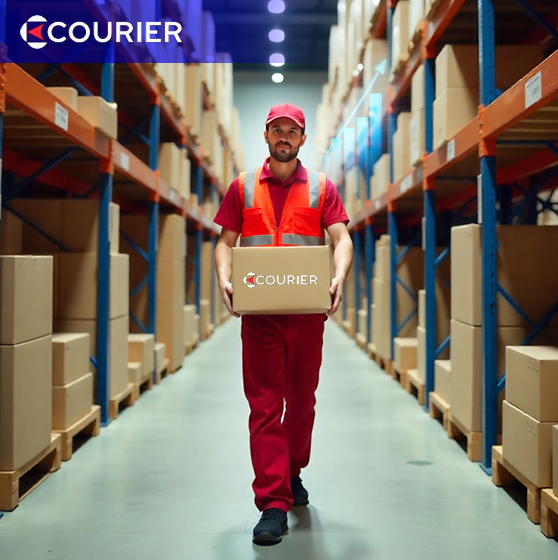
 25th September , 2025
25th September , 2025 
